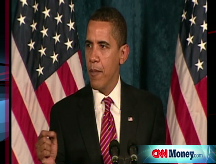Bonds slide: Eyes on auctions
Government bond prices slide Friday as supply concerns once again take center stage and after the January unemployment report .
NEW YORK (CNNMoney.com) -- The government bond market refocused on the tremendous volume of supply headed to market next week after a worse-than-expected jobs report sparked stimulus optimism.
Prior to the release of the government's employment report, debt prices were slightly higher but turned lower following the report. Selling accelerated as stocks rallied amid optimism that President Obama's stimulus bill would pass a vote Friday evening.
January's job losses, which were the worst on record in 34 years, only increases the urgency surrounding the need for an economic stimulus package. The government has been selling bonds to fund its various rescue packages.
"The numbers continue to be pretty weak, very weak, but the real concern for the government bond market is supply, the upcoming supply," said Brian Edmonds, head of interest rate trading, Cantor Fitzgerald.
The bond market has been wedged between two opposing forces. On one side, consistently bad economic news reaffirms the painful state of recession, motivating investors to keep their assets tucked away in the safety of government bonds.
However, the same recession that has investors socking their funds away in government bonds has the government spending at a rapid clip to resuscitate the economy.
"The market is trying to figure out how to grapple with all the supply, which is a technical negative in the marketplace," said Edmonds, "versus the fundamental positives, which are the weak economy and low inflation environment which we are currently in."
Obama, Geithner spending plans: The debate over the economic stimulus plan continues in the Senate Friday, with a bipartisan group of senators objecting to the size of the bill. The bill's heavy cost will mean more supply of government bonds in the pipelines.
Additionally, Treasury Secretary Tim Geithner is due to deliver a speech Monday to unveil a new plan for shoring up losses in the banking system. And that's adding to concerns about the debt supply.
While there is still $350 billion left in the Troubled Asset Relief Program from the bailout bill that was passed in the fall, the tab for Geithner's plan could expand beyond that.
Edmonds said that the bond market was "looking forward to Monday's announcement of the next step in the rescue plan." He said the bank recovery plan would likely support stock prices.
The Treasury announced its quarterly refunding plan on Wednesday, and the $67 billion worth of new long-term debt being brought to market was a record refunding announcement. The auctions were scheduled to begin Tuesday, Feb 10.
"The Treasury came out with its refunding and new issuance calendar," said Edmonds. "And it is pretty clear in the Treasury market that there is just a tremendous, tremendous amount of new issuance that will be coming into the marketplace in 2009."
Debt prices: The benchmark 10-year note fell 20/32 to 106-12/32 and its yield was up at 2.99%. The yield had jumped as high as 3% during mid-day trade. The 10-year bond has not closed above 3% since Nov. 25, when it ended at 3.11%.
Government bond prices and yields move in opposite directions.
The 30-year bond fell 26/32 to 114-12/32 and its yield rose to 3.69%. Meanwhile, the 2-year note edged down 2/32 to 99-25/32 and its yield rose to 0.99%.
The yield on the 3-month Treasury bill was 0.28%. The 3-month bill has been used as a short-term gauge of confidence in the marketplace, because investors tend to shuffle funds in and out of the bill as they assess risk in other places - the lower the yield, the more risk they see.
Bond prices have been moving mostly lower since the start of the new year, sending yields higher. With a number of borrowing rates - including conventional mortgage rates - based off Treasury yields, higher Treasury yields don't bode well for the struggling housing market. Higher mortgage rates deter home buyers.
"Higher interest rates have the potential to derail the stimulus, which is provided to the American consumer by historically low long term mortgage rates," said Edmonds.
Lending rates: The 3-month Libor rate continued to hold steady at 1.24%, according to data on Bloomberg.com. The overnight Libor rate, meanwhile, edged slightly lower to 0.31% Friday, down from 0.32% Thursday.
Libor, the London Interbank Offered Rate, is a daily average of rates that 16 different banks charge each other to lend money in London, and it is used to calculate adjustable-rate mortgages. More than $350 billion in assets are tied to Libor.
Two credit market gauges were mostly unchanged. The "TED" spread widened Friday to 0.97 percentage point from 0.95 percentage point the day before. The bigger the TED spread, the less willing investors are to take risks. The rate surged as the credit crisis gripped the economy, but it has since fallen off as central banks around the world have lowered interest rates and pumped liquidity into the economy.
Another market indicator, the Libor-OIS spread, slipped to 0.97 percentage points, from 0.98 the day before. The Libor-OIS spread measures how much cash is available for lending between banks and is used for determining lending rates. The narrower the spread, the more cash is available for lending. ![]()




